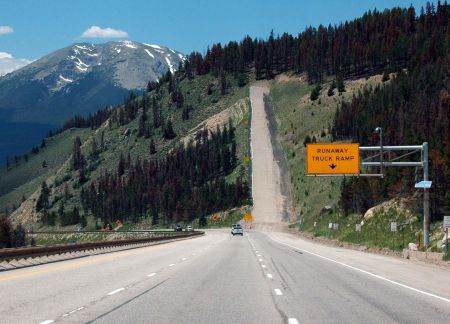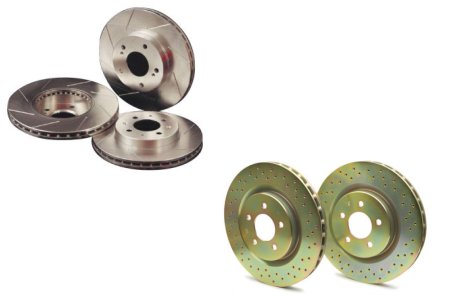Are Slotted or Drilled Rotors Worthwhile for Towing?
Jason Lancaster | Feb 11, 2009 | Comments 6
In part one, we talked about overheated truck brakes from towing or hauling and how slotted and drilled rotors can help. In this post, we’ll answer the question: Are slotted or drilled brake rotors worthwhile for towing?
Towing and or hauling can create some extraordinary circumstances for even the stoutest braking system. In the steep mountains of Colorado, “runaway truck ramps” are a common sight because so many trucks (big and small) experience brake failure. But are a set of drilled or slotted rotors going to make a big difference when you’re towing or hauling with your pickup?
In a word, yes. Drilled and slotted rotors are for real – they can improve braking performance in a lot of different situations. In many situations where a stock set of truck brakes would overheat and fade, after-market rotors will continue to perform. Of course, like any after-market part, there are a few trade-offs to consider.
Slotted and/or drilled rotors require more specialized maintenance. If and when your slotted or drilled rotors accumulate uneven patches of cooked-on brake pad material (known as “warping” to many), most brake shops won’t offer to scrub the rotors with garnet paper. Instead, they’ll simply state that the rotors are ruined and ask you to replace them. Maintenance for sophisticated slotted or cross-drilled rotors requires finding a brake shop that knows about garnet paper and the “blanchard” grinding process.
They’re usually louder. OEM brake rotors are usually smooth and flat, so when the pads contact the rotor, the contact is consistent. On drilled and/or slotted rotors, tiny breaks in contact (where the pad momentarily breaks contact with the drilled or slotted out portion of the rotor) leads to noise.
They’re dusty. Since cross-drilled and slotted rotors are better at keeping brake dust from accumulating on the rotor, that means that there’s more brake dust making it’s way to the wheels. You’ll spend more time cleaning the wheels on a vehicle with drilled or slotted rotors than one without.

Note the runaway truck ramp on the right side at the bottom of the hill. Trucks big and small make use of these ramps all the time.
They’re more expensive. This is the main reason you don’t see more cross drilled or slotted rotors on new vehicles. A good slotted or cross-drilled rotor (such as the rotors offered by Power Slot or Brembo) can cost the vehicle manufacturer two or three times as much.
They don’t necessarily increase brake pad life. While it’s true that after-market rotors stay cooler (even during heavy breaking), that doesn’t always mean that your brake pads will last longer with a set of drilled or slotted rotors. Brake pads, in fact, are an entirely different discussion.
They don’t necessarily improve braking distance. Most of the time, adding a set of quality after-market rotors will boost braking distance marginally (5%). Again, the main benefits to slotted or drilled rotors are cooling, not necessarily boosting braking power.

After-market drilled and or slotted rotors (like these from Power Slot and Brembo) are more expensive, louder, dustier, and require specialized maintenance than OEM rotors. But they also perform better during heavy towing and hauling.
So, do you actually NEED slotted or drilled rotors on your truck? If you tow or haul on a regular basis, or if you find yourself towing or hauling in steep mountains, the reduced risk of overheated brakes is definitely worth the additional cost. For a 2006 Toyota Tundra, you can buy a set of Brembo cross-drilled rotors for about $250, a set of Power Slot rotors for about $190, and a set of basic Beck Arnley stock rotor replacements for about $180.
On the other hand, if you don’t find yourself towing or hauling much, they’re likely overkill. Still, it’s important to recognize that they’re not much more expensive than OEM type rotors when it’s replacement time.
Bottom line: If you’re looking to replace your factory rotors, it makes sense to consider after-market drilled or slotted rotors. If you tow or haul often, it’s a good investment. If you rarely tow or haul, the factory rotors are more than adequate. It’s official – after-market brake rotors are for heavy-duty users.
Next up – after-market brake pads for towing and hauling.
Search terms people used to find this page:
- tundraheadquarters
Filed Under: Toyota Tundra Accessories


You really drilled that point home. Now we know exactly where to slot these options in.
Just in time…… I have 50,000 miles on my 07 Crewmax. I have about another 10,000 miles left and I will be ready to switch to a slotted set. Now for the pads. Next review.
How much louder when brake are applied using drilled or slotted brake rotor for toyota tundra? Which is the best rotor to purchase for a 2004 tundra double cab? Please help me.
Frank – The rotors aren’t much louder. Most people notice, but not so much that you’ll be majorly perturbed.
Ever thought of taking your tundra out of OD or dropping a gear going down a pass. There is no need to ride your brakes going down a mountain pass. Just gets them super hot, warps rotors, burns up pads. Ever notice the big trucks gear down and apply their brakes evenly?
Tonka – Of course – but gearing down often isn’t enough, especially when the pass has a lot of twists and turns. I never ride my brakes, and most of the time I never smell hot pads b/c I use engine braking. However, if you take a Tundra with a trailer down any number of Colorado mountain passes you’ll find that your brakes are nice and hot when you get to the bottom no matter how much engine braking you do.
Another thing that works very well for passenger cars is to pull over halfway down the hill and let things cool off. I do that sometimes as well. Of course, it’s hard to do that with a trailer (shoulders usually aren’t big enough).
Slotted and drilled rotors aren’t necessary, but they’re a nice add-on for performance or heavy towing vehicles.